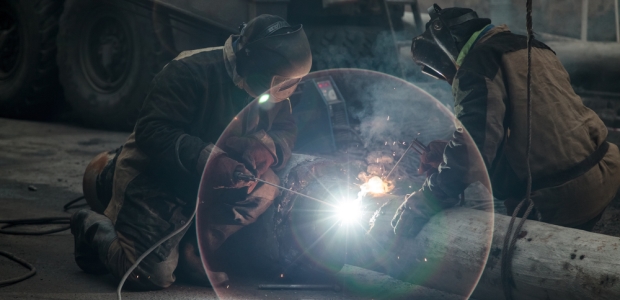
Fire Safety for Welders
A minor mistake or improperly placed object can send a room up in smoke. As tedious as it may seem, a welder should always do a spot check for combustible objects within the welding vicinity.
- By Tom Bonine
- Aug 01, 2015
Welding can be one of the most dangerous industrial professions, but it doesn't have to be. With the right knowledge, policies, and safety equipment, a welder can be well protected from personal injury or property damage.
It's not always easy, but professional welders and those who weld as a hobby should be familiar with the risks they are facing and should take every possible precaution. Below, read more about the fire safety issues associated with welding, as well as some ways to reduce the risk.
Property Damage
In welding, your setting can be your worst enemy, and it's not always new environments that can pose the greatest risk. Complacency in a familiar welding spot can lead to carelessness on the part of even the most seasoned welder. Depending on the nature of the welding project, the dangers can range from minor property damage to serious explosion. When it comes to combustion, here are a few of the more notable dangers to consider:
Loose objects
A minor mistake or improperly placed object can send a room up in smoke. As tedious as it may seem, a welder should always do a spot check for combustible objects within the welding vicinity. That can mean rags, clothing, even sawdust.
Combustible infrastructure
Not all building materials are welder friendly, and it's not always easy to separate the good from the bad. As you weld, consider your surroundings, especially floors, roofs, and walls.
Unseen openings
Even if an open flame doesn't immediately ignite an unwanted fire, the welder should be mindful of slags falling into cracks and small openings in a welding facility.
Pipes and tanks
Many of these carry flammable liquids or gases, and unless explicitly informed otherwise, assume they all do. All it takes is a single spark or ember to ignite an entire tank and cause a potentially catastrophic explosion.
Vapors
Naturally, fumes and vapors are more difficult to identify, but they can be just as dangerous. A welder should know to check and double-check tanks and gas lines that could be the source for leaked fumes.
Outdoor objects
It's a little tougher to tame the great outdoors, but a person welding outside should make every effort to do just that. Dry grass, shrubbery, or leaves don't take a lot to catch fire.
Personal Injury
When dealing with the intense heat of welding, it's not surprising that a welder exposes himself to serious personal risk. Here are a few of your body parts you should keep in mind:
Eyes
When you think fire-related injury, you naturally think of burns. Yet even observers who don't come in contact with the actual flame are at risk, especially their vision. Welders spend a lot of time staring at intense light that would blind a typical observer.
Body
Then there is a person's skin. If a welde'’s flame can penetrate steel, then rest assured it can do some damage to a person's skin.
Lungs
It's not always the case, but sometimes welding can result in unpleasant or downright noxious fumes. While not lethal in the short term, years of exposure can add up to breathing problems later on.
Mind
Heat exhaustion can be a killer. At the very least, it can wreak havoc on a person’s mindset and result in serious accidents. In addition, heat exhaustion can take an enormous physical toll.
What to Do
While the risks associated with welding are great, welders can take steps to significantly reduce them. Here are a few:
- Weld only in designated areas. In some cases, it's as easy as only welding in a shop that has been screened for any possible fire hazard. Of course, oftentimes you must do on-site welding. In those cases, maintain a checklist of common combustibles and make sure they are clear of your welding area. If you can't move them, cover them with fire-resistant materials.
- Keep first aid handy. Injuries do happen, and you must be prepared for them. Make sure your first aid kit includes bandages and burn creams. Keep a list of emergency phone numbers ready so that a victim can be professionally treated as soon as possible.
- Wear safety gear. You have countless options for personal safety equipment. Make sure you and any other welders in the vicinity have access to goggles and facemasks (in many cases, it helps to wear both) as well as fire-resistant clothing.
- Don't sweat. Seriously, don't sweat if you can help it. Your sweat becomes its own safety hazard if not kept in check. For starters, a sweaty hand is clumsy. Sweat is also conductive, and in a task that requires you to work so closely with electricity, you don't want to have wet hands or clothing. Make sure that any personal attire breathes well and can safely absorb sweat.
This article originally appeared in the August 2015 issue of Occupational Health & Safety.